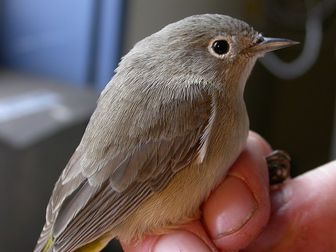Virginia's warbler
Despite what its name may suggest, Virginia's warbler is not actually named after the American State of Virginia, which makes sense as the birds range only reaches as far east as the state of Texas. The bird's common eastern range is central and southern mountains of Colorado, central Wyoming, and central and western New Mexico. The bird was named for Virginia Anderson, the wife of an army surgeon who discovered the bird at Fort Burgwin, New Mexico, in 1858. When Spencer Fullerton Baird of the Smithsonian Institution fully described the bird for science in 1860 he honored the wishes of the warbler's discoverer and designated Virginia to be both the bird's common and scientific name.

Original source: Own work
Author: Sabine's Sunbird
Permission: GNU Free Documentation License
The Virginia's warbler is classified as Least Concern. Does not qualify for a more at risk category. Widespread and abundant taxa are included in this category.
Virginia's Warbler, Vermivora virginiae, is a species of New World warbler. Despite what its name may suggest, Virginia's warbler is not actually named after the American State of Virginia, which makes sense as the birds range only reaches as far east as the state of Texas. The bird's common eastern range is central and southern mountains of Colorado, central Wyoming, and central and western New Mexico. More
Virginia's warbler is a small bird, only 4 to 4½ inches in length. It is mainly gray in color, with a lighter colored under-belly and a white eye ring. The rump and undertail coverts are yellow. Males also have a yellow patch on their breast and a red cap, both of which are lacking in female and immature birds. Virginia's warbler can be easily mistaken for the Colima Warbler, but it is smaller and has a more yellow rump. More
* Despite what its name may suggest, Virginia's Warbler is not named after the state of Virginia, which makes sense as the birds range only reaches as far east as the state of Texas. The bird was named for Virginia Anderson, the wife of an army surgeon who discovered the bird in New Mexico in 1858. More
A bird of the southwestern Rockies, the Virginia's Warbler is closely tied to dry pinon-juniper and oak woodlands during the breeding season. It winters in Mexico and may even breed there. Basic knowledge is lacking for this short-distance neotropical migrant, whose populations could be declining due to habitat alteration and global warming as well as Brown-headed Cowbird parasitism. Identification The adult male is gray with pale underparts, a yellow breast, white eye ring, and a rufous crown, which is often concealed. More
Virginia's Warbler winters along the Pacific slope of southern Mexico, primarily in the states of Jalisco, Guanajuato, Michoacan, Morelos, Guerrero, southern Puebla, and Oaxaca (Howell and Webb 1995). Virginia’s Warbler breeds throughout the western two-thirds of New Mexico; it is less common in the east where habitat is patchy. Summer populations of this species occur in the northern mountains, along the Mogollon Rim, throughout the Gila, and in all mountain ranges of central and western New Mexico (Goguen and Mathews 1998, Parmeter et al. More
Virginia's warbler is common in dense oak and pinyon woodlands and brushy streamside hills at altitudes ranging from 6,000 to 9,000 feet. It summers in the south-western United States and will migrate as far south as Belize during the winter, as well as stopping in several Caribbean islands such as the Bahamas, Cuba, and the Turks and Caicos Islands. More
Distribution: Virginia's Warblers breed in the Four Corners states of Colorado, Utah, New Mexico, and Arizona, with extensions into Nevada and extreme eastern California. A few occupy the Guadalupe Mountains of western Texas. In Colorado, these warblers nest primarily between 1500 and 2700 m (5,000-9,000 ft) in elevation. They breed most abundantly in the western quarter of the state, along the eastern slope foothills, and in the Upper Arkansas River drainage. They winter in the dense scrub of Mexico's semi-arid west-central highlands. More
Virginia's Warbler; sides brownish; lacks yellow on the breast. Voice: Song, "a simple trill, like that of Chipping Sparrow but more musical and ending in two lower notes" (J. Van Tyne). Range: Breeds in w. Texas (Chisos Mts.), n.-cen. Mexico. Winters in Mexico to Colima, Guerrero. Habitat: Oak-pine canyons. More
Virginia's Warbler was unknown in South Dakota until 1997, when many dozens of breeding pairs were found in extreme western Custer County (SDOU - "Birds of South Dakota" - 2002). They can be difficult to observe even in known breeding locations, given the density of vegetation they prefer to nest in. Habitat: Prefers low, dry, brushy habitats of the western U.S., including oak canyons, pinyon-juniper woods, and scrub oak. More
Virginia's Warbler: Diet consists mostly of insects. Forages on the ground, in foliage, or catches insects in mid-air. Readily Eats Sugar Water, Fruit, Nut Pieces Vocalization Virginia’s Warbler: Two part song with slurred notes. Call is "chink." Similar Species Virginia's Warbler: Lucy's Warbler lacks white eye-ring, yellow rump, and undertail coverts. Nashville Warbler has more yellow on underparts and more olive on upperparts. More
Plate 8 THE summer home of Virginia's Warbler (Vermivora virginiae) in the eastern portion of Colorado seems to be restricted to the ransitlon Zone. In the early spring when they first arrive from the south, they may be found along the cottonwood creek-bottoms of the prairies in company with other migrants, but after the first leaves of the scrub oaks appear, they are seldom found away from their favorite habitat. More

Original source: Sabine
Author: Sabine
Permission: Some rights reserved
Family : Parulidae
Genus : Vermivora
Species : virginiae
Authority : (Baird, 1860)

